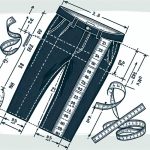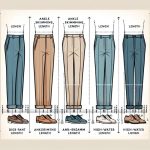As someone who appreciates a well-fitting garment, I often find myself pondering the intricacies of measuring clothing. When it comes to determining the outseam, precision is key, but the process can sometimes be elusive.
However, fear not, for in the following discussion, I will unravel the mystery behind measuring outseam, guiding you through the essential steps, tools required, and insider tips that will make certain your measurements are spot on.
So, let's commence on this journey to demystify the art of measuring outseam together.
Table of Contents
Key Takeaways
- Outseam measurement determines pant length and fit accurately.
- Precise measurements enhance clothing appearance and comfort.
- Proper tools and techniques ensure accurate outseam measurements.
- Understanding variations and using measurement charts aids in selecting the right size.
Importance of Outseam Measurement
Understanding why measuring the outseam is important can greatly impact the fit and comfort of your clothing. The outseam fit plays an essential role in how your pants or trousers drape over your body. It determines the length and the overall silhouette of the garment. Incorrect outseam measurements can result in pants that are too short, too long, or simply don't look right on your body shape. Making outseam alterations based on accurate measurements can transform an ill-fitting garment into one that enhances your appearance and boosts your confidence.
When the outseam is measured correctly, alterations can be made precisely to make sure the pants or trousers fit perfectly. This can involve adjusting the length of the outseam to achieve the desired look or feel. By understanding the importance of outseam measurement, you can take control of how your clothing fits, leading to a wardrobe that's both comfortable and stylish.
Necessary Tools for Measuring Outseam
When it comes to measuring outseam, having the right tools is essential.
In my experience, a measuring tape guide has been indispensable for accurate measurements.
Positioning the tape properly and recording the measurements diligently are key points to keep in mind.
Measuring Tape Guide
To guarantee accuracy when measuring outseam, having a reliable measuring tape is essential. Here are some key points to bear in mind when using a measuring tape:
- Material: Opt for a flexible measuring tape made of durable materials like fiberglass or vinyl to guarantee longevity and precision.
- Length: Choose a tape that's long enough to measure the full outseam length without needing to readjust frequently.
- Markings: Look for clear, easy-to-read markings on the tape to prevent misreading measurements.
- Locking Mechanism: Make sure the tape has a secure locking mechanism to hold the measurement in place, avoiding errors.
- Flexibility: A tape that can bend easily around curves will provide accurate measurements for various outseam variations.
Proper Positioning Tips
Having a reliable measuring tape is the foundation for properly positioning and accurately measuring outseam length. When preparing to measure outseam, make sure your body alignment is straight and natural. Stand upright with your feet together, maintaining a good posture. Keep your shoulders relaxed and avoid slouching.
A quick posture check can help guarantee an accurate measurement. Make sure the measuring tape is positioned flat against your body without any twists or bends. It's essential to maintain consistency in your posture throughout the measurement process to obtain precise outseam measurements.
Recording Accurate Measurements
For precise outseam measurements, make sure you have a reliable measuring tape and maintain proper body alignment throughout the process. Here are some essential tools for accurate outseam recording:
- Sharp fabric chalk: To mark the outseam fitting points clearly on the fabric.
- Seam gauge: Guarantees consistent outseam alterations by providing precise measurements.
- Iron and ironing board: To press the fabric before measuring, ensuring accuracy.
- Good lighting: Important illumination is critical for spotting any discrepancies in the outseam measurements.
- Notebook and pen: Keep a record of all outseam measurements and alterations for future reference and adjustments.
Step-by-Step Guide to Measure Outseam
When measuring outseam, start by laying the garment flat on a smooth surface with the legs extended. To measure the outseam accurately, follow these steps:
| Steps to Measure Outseam | |
|---|---|
| Step 1: | Smooth out the garment and lay it flat. |
| Step 2: | Extend the legs fully to guarantee a straight line. |
| Step 3: | Start measuring from the top of the waistband to the bottom of the hem. |
| Step 4: | Use a flexible measuring tape for precise measurements. |
Tips for Accurate Outseam Measurement
To guarantee accurate outseam measurements, always double-check that the garment is laid flat and the legs are fully extended before beginning the measurement process. Ensuring outseam accuracy and precision is critical for successful outseam tailoring or alterations. Here are some essential tips for achieving precise measurements:
- Use a Flexible Measuring Tape: A flexible tape allows for better conformity to the shape of the garment, providing more accurate measurements.
- Measure from the Waist: Start measuring from the waistband down to the desired outseam length for consistency in your measurements.
- Avoid Stretching the Fabric: Pulling or stretching the fabric while measuring can lead to inaccuracies, so handle the garment gently.
- Check and Recheck: Double-check your measurements to eliminate errors and make sure the outseam length is accurate.
- Record Measurements Immediately: Write down the measurements as you go to prevent any confusion or forgetting crucial numbers during the tailoring or alteration process.
Common Mistakes to Avoid
One common mistake to avoid when measuring the outseam is neglecting to account for any folds or creases in the fabric, as these can lead to inaccurate measurements. It's important to make sure the fabric is flat and smooth before taking the measurement.
Another common error is pulling the tape measure too tightly or too loosely. The correct technique involves placing the tape measure gently against the body without cinching it too snugly or allowing it to droop.
Additionally, failing to measure from the correct starting point, such as the natural waist for pants, can result in an incorrect outseam measurement. To avoid this error, always refer to specific garment measurement guides for guidance.
Understanding Outseam Variations
Outseam variations can provide valuable insights into the design and fit of clothing items. Understanding these variations is essential for tailoring garments to specific fitting preferences. Here are five key points to take into account:
- Outseam Variations: Different outseam styles, such as straight-cut, tapered, or bootcut, can have a major impact on the overall look and feel of a garment. Choosing the right outseam style is important for achieving the desired aesthetic.
- Fitting Preferences: Individuals have unique fitting preferences when it comes to clothing. Outseam variations play an important role in meeting these preferences, ensuring comfort and style align perfectly.
- Outseam Inseam Relationship: The relationship between the outseam and inseam is crucial for determining the appropriate pant length. Understanding how these measurements work together is important for achieving a well-balanced look.
- Pant Length: Outseam variations directly influence the length of pants, affecting how they drape and fit. Choosing the right outseam length is key to achieving a tailored and polished appearance.
- Personal Style: Outseam variations can also reflect personal style choices. Whether opting for a classic cut or a more modern silhouette, understanding how outseam variations impact style is important for creating a cohesive wardrobe.
Outseam Measurement Chart
When measuring pants for the perfect fit, consulting an outseam measurement chart can provide important guidance. These charts typically display the outseam measurements corresponding to different sizes, helping you determine the best option for your body type. By locating your measurements on the sizing guide, you can accurately select the appropriate outseam length for your pants, guaranteeing a comfortable and well-fitted garment.
Outseam measurement charts are organized by waist size and inseam length, offering a detailed overview of the various dimensions available. Understanding how to read these charts is crucial for achieving the desired fit, as they serve as a roadmap for selecting the right outseam measurement based on your unique proportions. By cross-referencing your measurements with the chart, you can confidently choose the size that aligns with your preferences and ensures an ideal length for your pants.
Frequently Asked Questions
Can the Outseam Measurement Be Different on Different Types of Garments, Such as Pants Versus Shorts?
Yes, the outseam measurement can vary between different types of garments. Pants and shorts typically have different lengths due to their distinct styles and fits. Understanding these variations is essential for tailoring options and achieving the desired look.
How Does the Outseam Measurement Affect the Overall Fit and Comfort of a Garment?
Understanding how outseam affects fit assessment and sizing accuracy is vital. The length impacts where the garment falls, influencing comfort level. Selecting appropriate fabric complements this, enhancing overall comfort and wearability.
Are There Any Adjustments That Need to Be Made When Measuring Outseam on Stretchy or Elasticated Fabrics?
When dealing with stretchy or elasticated fabrics, I adjust my measurements by considering the fabric type's stretchiness. Understanding the waist to outseam ratio becomes important as elasticity can impact the fit and comfort of the garment.
Is There a Standard or Recommended Outseam Measurement for Specific Garment Sizes, or Does It Vary by Brand and Style?
When it comes to sizing consistency, outseam measurements can vary by brand and style. Different brands may have their own standards, so it is crucial to refer to specific brand size guides for accurate measurements.
How Can Outseam Measurements Be Used to Determine the Best Length for Alterations or Customizations on a Garment?
Understanding outseam measurements is pivotal for alteration techniques and customization options. By analyzing the outseam significance, fitting considerations can be tailored to create the best length for garment modifications, ensuring a personalized and precise fit.
- The Use of Nonwovens in Construction and Civil Engineering - July 11, 2025
- The Use of Nonwovens in Construction and Civil Engineering - July 11, 2025
- The Use of Nonwovens in Construction and Civil Engineering - July 11, 2025






